Fulwell Golf Club - Feels like Evans...
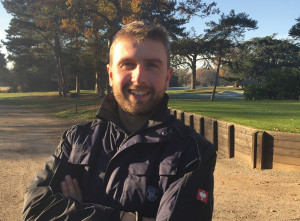
Sam Evans has been Head Greenkeeper at Fulwell Golf Club for one year, joining in February 2016. The club employ the services of the renowned Greg Evans (he of 'cut it short' fame) whose role as Head of Golf Course Development ensures that Sam is left to concentrate on the day to day running of the 6,465 yards, par 71, parkland course.
Working with a team of six qualified greenkeepers, two apprentices and two weekend staff requires detailed planning and work allocation, but how exactly did he rise through the ranks to get to his present position? In this question and answer session, Sam provides an insight into his role.
How did you get into the industry and where did you work prior to your current position?
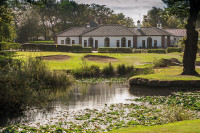
Upon completion of my degree, I continued full time at Heythrop. After a few years, a brief time away from the industry and a second stint at Heythrop Park, in June 2013, I started as Deputy Course Manager at Oakland Park Golf Club in Buckinghamshire. Eighteen months later, my boss moved on and I was promoted to Course Manager, until February 2016, when I started at Fulwell.
Was there one person who has been an inspiration you?
Difficult to just say 'one person', but my father has inspired me to always do the best I can from a young age. However, Graham Down, who employed me as his Deputy at Oakland Park, was an important figure in my career. That period was a great time for me, I learned a lot from him and he has helped me get to where I am today.
Are you responsible for budgets or do you report to someone else - for example a greens chairman or committee?
I work closely with Greg (no relation) Evans on budgets, but he will report to the board.
What is the total acreage and how is this divided up?
136 acres: 1.3 hectares of greens/collars, 1.3 hectares of approaches, 11.5 hectares of fairways and one hectare of tees.
What additional staff do you have (names, ages, length of service)?
I am in a very lucky position as all the staff are skilled in a number of areas and I can feel comfortable having any one of them doing any task.
This is great because, during projects or deadlines, I can have 'all hands to the pump' to get the job done.

Sean Eckett - Senior Greenkeeper/Irrigation Technician (26/9)
Chris Fogg - Senior Greenkeeper/Mechanic (29/12)
John Hordlay - Assistant Greenkeeper (58/12)
Will Turner - Assistant Greenkeeper (24/5)
Alex Bueno - Assistant Greenkeeper (25/5)
Albi Richardson - Apprentice Greenkeeper (18/1)
Robbie Lister - Apprentice Greenkeeper (29/1)
Chris is our Workshop Mechanic. He has been at the club for twelve years - ten of those as a greenkeeper - but, in a relatively recent rejig of the department, he became mechanic in July 2015. In this time, he has achieved a mechanic qualification and has been on a number of dealer courses to improve his skills and knowledge.
We are trying to do as much servicing and machinery maintenance in-house as possible but, if required, we will outsource this.
Dan and Will are responsible for spraying tasks. Sean and Alex are normally working with irrigation, drainage or construction when not on the course.
John, Robbie and Albi are able to help out with projects, but will normally set the course up for play.

As previously mentioned, Greg Evans is employed as Head of Golf Course Development. He oversees all that we do in the greenkeeping team, helps plan projects and is a link between us and the members. It is working really well so far, and it is great to bounce ideas off him and use his previous experiences to ensure that we produce the best surfaces we can at Fulwell.
Are you and your staff compliant with current legislation?
Very much so. The club are welcomingly hot on this, and we offer ongoing training to ensure that remains the case. We have lots going on. For example, just this winter we have two on level 3, three on level 2, three on digger licence, one on trailer licence, three on CAT and Genny training and two on MS Excel courses. We also have CPR, defib, H&S courses and I had four members go up to BTME to attend seminars.

How would you describe the soil profile?
Very rich and heavy, however it appears that, in most areas, once we go lower than 300-400mm, the soil becomes stony and gravelly, which is a great benefit.
How were the greens and tees constructed?
They are soil push ups. However, the 18th green was rebuilt a number of years ago to a USGA spec. The tees are a mixture and we are part way through working on the weaker/wetter tees. To do this, we are producing a bigger teeing space, new drainage and fresh rootzone. Oddly, the USGA spec green does seem to get disease first, even though it is the same grass species. The lads use this as a gauge with the rest of the greens.
We use temporary greens for white frost. We put golfers back on the main greens once the fairways are no longer white. The main reason for this is to prevent frost building on shoes and then walking on and damaging the greens.
We are extremely lucky to have a decent size driving range, a putting green and a chipping green.
How do you handle water on the course - getting it off, getting it on?

We don't suffer with any weather extremes here, just the bad English weather in general, but we all must deal with that!
Are there any issues with shade and air flow?
Every golf course has a handful of areas that are weak due to air flow or shade. I have a number of small problem areas on the edges of greens caused by shade and tree roots, but we are hoping to overcome this over the next few years with regular coring and overseeding.
Tell us about your maintenance regimes, machinery and products used.
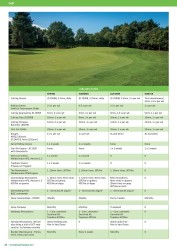
Where does presentation rank?
Extremely high. Essentially, golf courses are products, similar to a box of cereal you buy in the supermarket. You will normally buy based on price, how it looks, previous experience or recommendation. It's the same with golf courses. With competition so high for members, I feel it is crucial to ensure our golf course can be proud of what it is and what it has to offer. Presentation is the top layer of this. You can have an amazing sub soil or workshop setup but, if that initial presentation isn't there, you will struggle to get those golfers back and improve your reputation.
Thankfully, the playing surfaces here at Fulwell are of a great standard and keeping on top of this is important, but this means we can continue to focus on presentation all over the golf course, with bunkers, strim lists, cleaning furniture etc., along with the 'joyful' continuous blowing in the autumn months to help golfers find their ball. The team are extremely hot on presentation and we are starting to introduce 'think like a golfer' presentations to ensure the lads have the skills to understand what golfers want to see and fulfil this.
What end of season and ongoing renovations do you undertake?
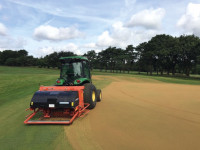
Obviously, the works must meet the budget, however the club realise the importance of renovations, but it does all come down to budget.
How have changing weather patterns affected what you do?
We can start renovations a lot earlier than previously, as there is much more growth early in the season, and recovery is a lot better. Increasing the sand in the profile is crucial for drainage and getting sand into the holes we make to act as channels is critical to keeping surfaces drier with increased rainfalls.

I am always looking at the profile, to see how affective the work we are doing is. However, 'official' soil samples are every November, purely to see where we are at in comparison to last year.
How do you interact with your club members - for example, regular newsletters, notice board or course walks?
We have quarterly presentation evenings to explain what is going on out on the golf course. These work well and give the members a chance for questions and explanations. A board report also goes out monthly explaining what is going on. We have an operations committee which is the link between the members and the staff, we meet monthly and have at least three course walks a year. We also have two divot parties a year where members can come along and discuss the course; whether it is complaints, improvements or general feedback, this can be positive. In the past, the club has had greenkeeper open days which welcomed members to the compound to look around our working space and machinery, and this is something I would like to re-introduce.
Do you have any tips for better communication?
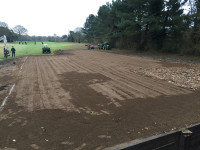
Are you working on any special projects at the moment?
Lots! We started the winter by draining two greens collars. We have just finished adding over 1000m of drainage to the 15th fairway. We are currently in the middle of rebuilding the 16th tee and phase one of our bunker renovation started in January. As well as this, we have the normal leaf collection, ditch work, tree work and course presentation. You could say we are pretty busy!
Several tees have already been rebuilt and are working great. A lot of tree work has also taken place, with woodland and scrub areas being thinned out to be mown between, just leaving good quality plants and trees.
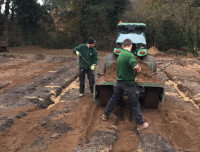
Does your course suffer from specific disease outbreaks?
Fusarium and Anthracnose have appeared since my arrival in February. Fusarium is all over the country now and, with the increased wet and warm weather, there are periods of high disease pressure that we try to manage around to prevent an outbreak. Anthracnose came in at the end of July, however I am led to believe that this is the first attack of anthracnose in several years, so we will need to keep my eye on that.
How do you undertake pest and weed control?
Continually spraying for weeds when required. Pests are becoming a nightmare as all preventative sprays seem to be massively reduced.

We have a hunter come in overnight once a week to limit the rabbits, but they seem to be multiplying ... like rabbits!
How important do you consider the local flora and fauna?
We have a large area of long rough which is there for over 75% of the year, however I would like to introduce some wildflower areas that have worked for me in the past. We are currently deciding on where to put them so I can prep the area.
We do have an environmental policy in place, but it is quite generic. We are working very closely with the council at the minute as we have a TPO (tree protection order) on our site, so I am in regular communication.
We use our local tree surgeon to help us with our TPO applications and sometimes to act as an agent.
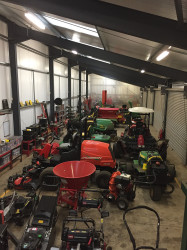
John Deere TX Gators x 2
John Deere TS Gator
Kawasaki Mule
John Deere 2500B triplex greens mowers x 2
John Deere 2500E triplex greens mower
John Deere 2500A triplex greens mower
John Deere 2500 triplex greens mower
Jacobsen G-Plex
John Deere 3235c fairway mower
Baroness LM2700
John Deere 2653a utility mower
Jacobsen AR522
John Deere ProGatorA + HD200
John Deere ProGator + Propass Topdresser
Smithco Roller
Ferris zero-turn mower
John Deere 1445 rotary mower
John Deere 4710 tractor with loader
John Deere 4520 tractor
John Deere 3320 compact tractor
Digger
Agrimetal BM300
Tornado Blower
Wiedenmann Rake
Wiedenmann Brush
Wiedenmann Super 500
Wiedenmann Core Recycler
Wiedenmann Terra Spike XP6
John Deere Aercore 1.6
Kensett TB200 Contra-Brush
Various chainsaws, strimmers, hedgecutters and blowers
Flymo hover mower
Bearcat Chipper
Toro Greensmaster 1000 x3
Hayter Harrier
Blec Overseeder
Charterhouse Overseeder
Blec Groundbreaker
Classen Turfcutter
Wackerplate
Trailers
GreenTek attachments: brushes, star slitters, scarifiers, sarrel rollers, verticutters, rollers, deep slicers, soft rotary brushes
Bernhard Grinders
"We purchase equipment outright from local dealers. I like to get the best machine for the job and the site, rather than sticking with one brand.
We have a Hydroscape wash down area that is compliant with current legislation.
We hire in an 8 tonne digger for any large project work. We also hire in an Air2G2 with operator twice a year, plus a tractor and 2m verti-drain to hollow core the fairways in spring and solid tine them in autumn. A tractor/flail/operator is brought in to tidy hedges around the course."
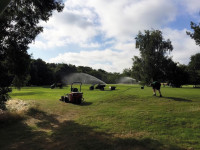
How do you see your job changing in the future?
I think the role of Head Greenkeeper/Course Manager will become more management based and I can see the role of Secretary/General Manager and Golf Course Manager becoming more united, but this may be a long way off.
How do you balance work with your personal life?
It is difficult, living on site it can be too easy just to 'nip' over to the office to do this or that. But I try to leave the mobile phone in another room or keep myself busy with the family to switch off from work. I think if you asked the wife this question she would say that this is something that has a lot of room for improvement.
What would you consider to be the state of our industry?
Confusing. I seem to be hearing stories of people always wanting more money, being undervalued or wanting a better deal, but I personally feel that you live to your means. If more money is what you want, you need to think about how to get it and what you have to do. I had to take jobs on lower wages and long travel times to get my experience and opportunities. I remember setting my alarm for 1.30 in the morning to head to the Buckinghamshire to help at a competition there, and then return to work and do a full day! However, the experience I had helping out was priceless.
It seems that people want something for nothing, but making sacrifices in the short term can dramatically help your long term. It is a hard job but, for me, the passion and love of the job overtakes the financial reward. With regards to chemicals in the industry, it also appears confusing and things are being taken away from us without any real validation or reasoning. I would love for a department somewhere to be impartial and act as the greenkeepers link to the authorities, so we know the facts, what is going on and why.
Are we undervalued?

How would you raise our profile?
I think increased interaction with members will increase our profile personally and professionally. Regular meetings or presentation evenings, play golf with members or against members, have yard open days for members to have a look at our working zone. Perhaps involving your secretary or captains with industry events such as BTME would also be beneficial. I think we need to try to get golfers discussing their greenstaff in a positive way, but we need to make sure they have the knowledge to do so. This will then snowball between clubs and the profile of greenstaff will grow.
Do you and your staff attend industry shows, seminars, demo days, road shows?
I try to get the lads to go to as many as possible. I try to rotate who goes as often as possible. A small number of us attend BTME every year, additional education days and golf days. I like to try and arrange two course walks a year at other golf clubs where I get everyone to attend, just to see what goes on at other clubs.



